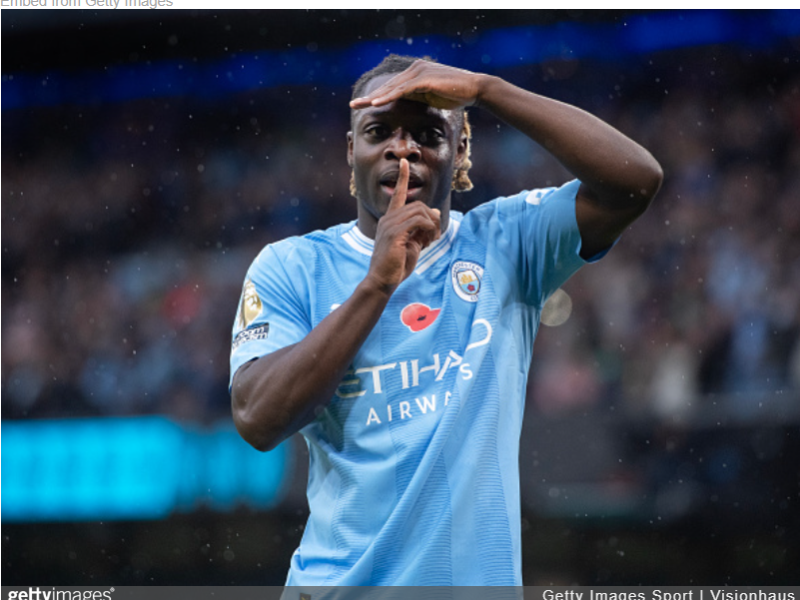In 2022, I established my ‘Role Continuity Evaluation System’, on the basis that players should be assessed by the metrics and traits important to their specific role on the pitch. Through this understanding, players are then classified into what is now 20 different roles, and assessed accordingly to see how they stack up to other players fulfilling the same player type. Here is an explanation of my scouting & analysis system, why I’ve coined it ‘Role Continuity’, and how I use the system to analyze defensive midfielders.
WHAT ARE YOU TALKING ABOUT, RHYS?
Embed from Getty ImagesRole Continuity might sound like a term from organizational psychology, but it’s actually taken from personality psychology. The theory is that personalities are formed not through the physical environments in which we live, but through the various roles we take up in society within our environments. The tasks that we do everyday become a major part of our identities, and even shape our personalities that we present to the world.
Embed from Getty ImagesTaking this over to a sporting context, the idea is that player traits, identities, and even “personalities” are formed through the roles they take up on the field of play for their teams. They develop those traits from being put into positions and roles to repeatedly harness them.

Further, when assessing these players and their actions on a pitch, we should not do what the free statistical websites do (I love many of these sites, don’t get me wrong!). A defensive midfielder should not be expected to perform the same actions as a striker. Their performance in a match (or over the course of a season for that matter) should not be assessed in the same way as a goalkeeper. Instead, we should be assessing their metrics and performance based on what is actually important to them and their role.

So how do we then put players in specific roles, when a player’s role might change over time?
Through ‘role continuity’. Through what roles they frequently adopt for their team over time. Since we have metrics that are important to each role, this can be assessed both through data, and the eye test. The goal is then to provide quality analysis and in-depth player assessments that adequately cover the vast array of different tasks that they are to fulfill within their job description. Those ‘job descriptions’ have been formed via what players in those roles have been asked to do over time, and their repeated perpetuation of reaching higher on certain statistics over others.
Embed from Getty ImagesIn this series, I’ll be breaking down how I analyze and compare players within each of the twenty roles. This article is all about the discrepancies between the different defensive midfielders in our player role system.
HOW I COMPARE DEFENSIVE MIDFIELDERS
Embed from Getty ImagesSimilarly to centre-backs, we’ve reduced defensive midfielders down to just two types – one that is more physically imposing, and one that dominates the ball.
The previous system also incorporated a third role – representing those strange ‘in-betweeners’ that don’t really do either to the highest extent, despite doing a bit of both. We called that the ‘Anchor’, since these were typically taller players that sat in front of the back four, screened the opposition’s striker, and did the simple actions as other players took more control.
Embed from Getty ImagesThe intention was to represent the discrepancy between ‘Midfield Destroyers’ that love to make their presence felt on the defensive end (e.g. Casemiro), and those that tend to do more subtle shuffling and screening (e.g. Busquets). But even in our example, there lies the problem! The Busquets types could never qualify as an Anchor, because they were too good on the ball. All of our true ‘Anchors’ were naturally more defensive players. It then made logical sense to combine them into that ‘Midfield Destroyer’ category.
Embed from Getty ImagesThe ‘Anchor’ is now a sub-type of the ‘Destroyer’ that we can pinpoint to clubs, helping them to realize which ‘6’s’ are more all-action leg-lunging tacklers, and which are more likely to do the simpler, meticulous defensive work. Since combining the two together, we’ve actually found a surprisingly few amount of ‘Anchors’.
Embed from Getty ImagesThat’s because most of those smart shufflers are like Busquets. That is, they’re actually ‘Deep-Lying Playmakers’ for their teams. The ‘Deep-Lying Playmaker’ is a #6 that dominates the ball, dictates the tempo of the match, and sits in a reserved role in and out of possession. They might occasionally advance forward, but their role is more about holding down the gauntlet in central midfield.
Embed from Getty ImagesNow here’s something else that exists at the top-end of every player role. The best of the art could theoretically qualify as both ‘Deep-Lying Playmakers’ and ‘Midfield Destroyers’. Rodri is likely the best in the world in just about every category you’d want for a ‘6’, smartly adjusting his position, dominating his defensive duels, but also dictating much of the possession for Manchester City.

Declan Rice seamlessly transitioned between a defensive West Ham team to a more possession-heavy role for England. Teresa Abelleira dominated defensive transitions, while also producing more chances and crosses than any of her Spain teammates in the lead-up to World Cup glory. The best of the art do both.
Embed from Getty ImagesSo how do we classify them if they do both so effectively?
I’d love to say ‘simple!’ and tell you that I look at which numbers spike higher, and evaluate team possession. That would be logical. But the answer is actually irregardless of team possession. If your role is intended to be more important in spreading play, orchestrating attacks, and aiding build-up, you’re a ‘DLP’ (Deep-Lying Playmaker). That includes the likes of Rodri, Rice, and Abelleira. If your role is more about breaking up play in transition and holding down the fort as others go forward, you’re a Midfield Destroyer. That includes the likes of Casemiro, Fabinho and Katrina Gorry. Sounds simple right?
Embed from Getty ImagesBut how do you evaluate this when Casemiro’s great at playing long passes, and Rodri could stop a train? This inherently requires the eye test. It’s not something that AI can automatically and accurately assess. Joshua Kimmich and even Sergio Busquets make a ton of defensive actions, and ‘AI’ would likely say they were defensive prototypes if team possession statistics were ignored. But they also complete an insane amount of their forward and long passes, and do so with elegance and poise.

When assessing data to classify players, the discrepancy then needs to come about in relation to their peers. How many passes do they complete in relation to their peers? How accurate are their passes in relation to their peers? How many defensive actions do they make in relation to their peers? How successful are they in their defensive duels in relation to their peers? Data in that sense is great. Put Casemiro against the best ‘DLP’s in our system, and he does not hold water. His forward and long passing is good, but it pales in comparison to Kimmich, Rice, Rodri, and Busquets. Data checks that box.
Embed from Getty ImagesBut if possible, it needs to be backed up with the eye test. And the way we do that is through context clues. Casemiro’s role has never been about spreading play forward and being ‘the man’ to shine on the ball. Toni Kroos held that responsibility at Real Madrid, and Christian Eriksen tends to be the deep-lying spreader at United.

Again, it’s about where the most importance lies for their team. Often times, you can gain clues about that from the construction of teams. Many ‘Midfield Destroyers’ sit next to someone meant to dictate more of the possession from deep (typically a ‘Tempo Setting’ #8). In the debate of who you want spreading play forward for Manchester United, most would go with Christian Eriksen over Casemiro, even in spite of Casemiro’s solid ball retention and progression.
Embed from Getty Images‘Deep-Lying Playmakers’ don’t tend to sit next to ‘Tempo Setters’, since they’re already the person setting the tempo. They tend to sit next to ‘Box to Box Midfielders’ in some capacity, whether that be someone holding more defensive emphasis in that box-to-box capacity like N’Golo Kanté (Shuttler) operating next to Jorginho, or someone more elegant like Aitana Bonmatí (‘Midfield Maestro’) next to Teresa. The duo of Keira Walsh and Georgia Stanway is a great example.
Embed from Getty ImagesStanway will still involve herself in possession, but it’s Walsh who is meant to be the key orchestrator from deep, as Stanway roams higher up the pitch and makes her presence felt closer to the opposition’s goal.
Embed from Getty ImagesThis is not a hard-and-fast rule! Don’t get me wrong. 3+2 build-ups will still position two ball-savvy midfielders alongside each other. Forge FC use Kyle Bekker next to Alessandro Hojabrpour, giving them more angles to dominate possession from deep. Possession-based 4-3-3 formations can still exist in the ways we saw with Xavi alongside Busquets in the heydays of Spanish football on the men’s side.
Embed from Getty ImagesBut it’s a rare combination, even for clubs that dominate the ball like Barcelona! Since they’ve lost Busquets, Xavi’s needed to restrict İlkay Gündoğan to more of a tempo-setting role, alongside the defensive presence of Oriol Romeu. With Busquets as the #6 in that equation, we might be less likely to see Gündoğan sitting so deep in possession, and having more license to be box-to-box instead.

From a player profiling perspective, the point is that context clues can help to understand which all-rounders are meant to be more defensive in their role, and which players are meant to be more possession-oriented within that #6 slot. HFX’s Lorenzo Callegari loves a tackle just as much as he loves a long pass. He’s equally intelligent at both sides of the game. But he sits next to the last ‘Anchor’ on earth in Mohamed Omar. Omar operates in a reserved position, and makes the simple passes rather than the line-splitting ones that you see from Callegari. That’s why we have Callegari in the ‘DLP’ role for HFX, with a secondary player type behind his name too – ‘Midfield Destroyer’.

This is all to say that the construction of a team and use of the eye test can help to elucidate the player’s role for this position, and needs to be used alongside data. One more reason not to solely rely on data when putting players into roles!
Embed from Getty ImagesSo once more, in finding players for clubs, we might test players like Callegari against other ‘Midfield Destroyers’ that do far less of the ball-savvy actions. He’ll naturally score higher, because he’s ‘all-action’. We can then point out to clubs that want someone doing more of the simple actions in sitting, screening and shuffling, that his teammate Omar might be a better fit for them. We can also test Callegari against others in the ‘DLP’ role. Again, he’ll spike higher because he does so much positive work on the defensive end.

This time, that will unequivocally be valued. ‘Defensive midfielders’ must still stand-out on the defensive end. We can communicate that he’s someone that can provide everything you want in dictating flow and pushing the envelope in possession, while also providing enough defensive cover for your attack-minded players.
Embed from Getty ImagesThe ‘Player Roles’ in our system are helpful in comparing players, but they are not meant to pigeon-hold a player into only being capable of fulfilling one role for a prospective club. So for players like Callegari, we can elucidate just how valuable they’ll be on all phases of the game – which is naturally what our data comparisons aim to do anyway! That’s what many of the top clubs are doing these days, prioritizing players like Alexis Mac Allister (Liverpool) or Jill Roord (Manchester City) that can fulfill multiple different roles. Since defensive midfielders lead both build-up and defensive transitions, it’s imperative that they can do both.
Embed from Getty ImagesYou can get away with pairing a slower ball-savvy defender with a physical specimen sprinting and covering space in behind when it comes to centre-backs. But with true #6’s often being that lone pivot, you can’t get away with that to the same extent. So even in separating players (like Casemiro and Rodri), we want to identify players that are fantastic at both personas (like Casemiro and Rodri).
Embed from Getty ImagesIf you’re interested in the specific metrics used for defensive midfielders in our analyses/player comparisons, simply reach out. We work with pro clubs to establish comprehensive scouting databases based on their ideal prototypes for each role. You can see an example of our Player Rankings for each role and how we build profiles while also exploring some of the best talent in the Canadian Premier League.

Now of course, data is not the end point. Players are assessed through the eye test and video analysis, where player reports can be created for the club. This is the most essential phase of the scouting process. I’ll be providing a few articles about how I use Wyscout and their video clips for my analyses and player comparisons, and how I use the eye test to compare the exact same features I scan for in statistical analyses.

I’ll also be breaking down how I analyze players in all of my player roles in the next few weeks. In the meantime, you can check out a few examples of our ‘Role Continuity Evaluation System’ in action. Thanks for reading and see you soon!
-> Canadian Premier League – Player Power Rankings
-> Explaining the Midfield Destroyer – Player Role Analysis
-> Explaining the Deep-Lying Playmaker – Player Role Analysis
-> Explaining the Anchor – Player Role Analysis
YOU MIGHT ALSO ENJOY…
Game of Numbers #36 – Role Changes for Dejan Kulusevski & Konrad Laimer
One thing is for certain. Spurs have not been the same since injury to James Maddison. Spurs were flying high with no signs of slowing down at the start of the season. But injuries across the squad have since stunted their progress and made for a more difficult second half of the first half to…
Game of Numbers #35 – Anthony Gordon’s embodiment of the Newcastle way
Newcastle United have been defined in the Eddie Howe era by energy and intensity, including an all-out press, and fervid counter attacking immediately upon regaining possession. Anthony Gordon perfectly embodies the Newcastle way under Eddie Howe, and has been one of the surprise stars of the 2023-24 season. Many scoffed at Chelsea’s interest in the…
Game of Numbers #34 – Dribbling lessons from Jérémy Doku & Midge Purce
Gotham FC finished the 2023 NWSL season in sixth place, narrowly scraping into the playoffs on goal differential over the Orlando Pride. They were far from the favourites to make the playoff final, let alone win the whole thing over a star-studded team like OL Reign. Yet thanks to a double-assist from Midge Purce, the…
GET IN TOUCH WITH RHYS & LEARN MORE ABOUT TMS!

I am currently accepting new clients in my coaching & mentorship program. I work with coaches and players from around the world! If you’re interested in learning more about my site or experiencing my coaching, feel free to reach out! 👊⚽
rhys desmond – founder of themastermindsite
Across the past decade, I have worked with thousands of players and coaches across multiple sports and disciplines. I recognize the value of diving deeper beyond the first glance, and uncovering the deeper-lying ways to enhance performance. I make a commitment toward positive reinforcement, research-backed insights, and making the experience fun for those that work with me.




